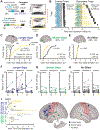Stimulation of caudal inferior and middle frontal gyri disrupts planning during spoken interaction
- PMID: 38823382
- PMCID: PMC11187660
- DOI: 10.1016/j.cub.2024.04.080
Stimulation of caudal inferior and middle frontal gyri disrupts planning during spoken interaction
Abstract
Turn-taking is a central feature of conversation across languages and cultures.1,2,3,4 This key social behavior requires numerous sensorimotor and cognitive operations1,5,6 that can be organized into three general phases: comprehension of a partner's turn, preparation of a speaker's own turn, and execution of that turn. Using intracranial electrocorticography, we recently demonstrated that neural activity related to these phases is functionally distinct during turn-taking.7 In particular, networks active during the perceptual and articulatory stages of turn-taking consisted of structures known to be important for speech-related sensory and motor processing,8,9,10,11,12,13,14,15,16,17 while putative planning dynamics were most regularly observed in the caudal inferior frontal gyrus (cIFG) and the middle frontal gyrus (cMFG). To test if these structures are necessary for planning during spoken interaction, we used direct electrical stimulation (DES) to transiently perturb cortical function in neurosurgical patient-volunteers performing a question-answer task.7,18,19 We found that stimulating the cIFG and cMFG led to various response errors9,13,20,21 but not gross articulatory deficits, which instead resulted from DES of structures involved in motor control8,13,20,22 (e.g., the precentral gyrus). Furthermore, perturbation of the cIFG and cMFG delayed inter-speaker timing-consistent with slowed planning-while faster responses could result from stimulation of sites located in other areas. Taken together, our findings suggest that the cIFG and cMFG contain critical preparatory circuits that are relevant for interactive language use.
Keywords: cognition; cortex; interaction; language; neurosurgery; planning; speech; stimulation.
Copyright © 2024 Elsevier Inc. All rights reserved.
Conflict of interest statement
Declaration of interests The authors declare no competing interests.
Figures



Similar articles
-
A frontal cortical network is critical for language planning during spoken interaction.bioRxiv [Preprint]. 2023 Dec 2:2023.08.26.554639. doi: 10.1101/2023.08.26.554639. bioRxiv. 2023. PMID: 37693383 Free PMC article. Preprint.
-
Three- and four-dimensional mapping of speech and language in patients with epilepsy.Brain. 2017 May 1;140(5):1351-1370. doi: 10.1093/brain/awx051. Brain. 2017. PMID: 28334963 Free PMC article.
-
Timing and location of speech errors induced by direct cortical stimulation.Brain Commun. 2024 Mar 19;6(2):fcae053. doi: 10.1093/braincomms/fcae053. eCollection 2024. Brain Commun. 2024. PMID: 38505231 Free PMC article.
-
A Neurosurgical Functional Dissection of the Middle Precentral Gyrus during Speech Production.J Neurosci. 2022 Nov 9;42(45):8416-8426. doi: 10.1523/JNEUROSCI.1614-22.2022. J Neurosci. 2022. PMID: 36351829 Free PMC article. Review.
-
A rostro-caudal axis for language in the frontal lobe: the role of executive control in speech production.Neurosci Biobehav Rev. 2014 Nov;47:431-44. doi: 10.1016/j.neubiorev.2014.09.008. Epub 2014 Oct 8. Neurosci Biobehav Rev. 2014. PMID: 25305636 Review.
Cited by
-
Speech sequencing in the human precentral gyrus.Nat Hum Behav. 2025 Jul 16. doi: 10.1038/s41562-025-02250-1. Online ahead of print. Nat Hum Behav. 2025. PMID: 40670697
References
-
- Heldner M, and Edlund J (2010). Pauses, gaps and overlaps in conversations. J. Phon 38, 555–568. 10.1016/j.wocn.2010.08.002. - DOI
-
- Sacks H, Schegloff E, and Jefferson G (1974). A Simplest Systematics for the Organization of Turn-Taking for Conversation. Language 50, 40.
MeSH terms
Grants and funding
LinkOut - more resources
Full Text Sources

